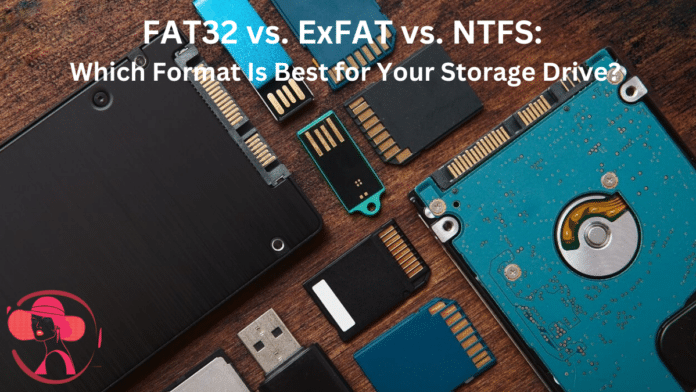When setting up a new storage drive or reformatting an existing one, choosing the right file system is crucial. The three most common file systems are FAT32, exFAT vs. NTFS. Each has its own strengths and weaknesses, making them suitable for different use cases.
This article will explore the differences between FAT32, exFAT vs. NTFS, helping you decide which format is best for your storage needs.
What is a File System?
Operating systems use file systems to organize, store, and manage files on a storage device. File systems define how data is stored and retrieved, ensuring efficient and reliable access to files.
The choice of file system affects compatibility, performance, and features available on your storage drive.
FAT32
FAT32 (File Allocation Table 32) is one of today’s oldest file systems. Introduced in 1996, it is widely compatible with various devices and operating systems.
Pros of FAT32:
- Compatibility: FAT32 is supported by almost all operating systems, including Windows, macOS, Linux, and gaming consoles. This makes it ideal for drives that need access across different platforms.
- Simplicity: Its simple structure makes it less prone to corruption and easier to recover if something goes wrong.
Cons of FAT32:
- File Size: FAT32 can only handle files up to 4GB. This is a significant limitation if you need to store large files, such as high-definition videos or large software applications.
- Partition Size: The maximum partition size for FAT32 is 8TB, but many operating systems limit it to 2TB.
- Modern Features: FAT32 lacks advanced features such as file permissions and encryption.
ExFAT
Microsoft introduced ExFAT (Extended File Allocation Table) in 2006 as a successor to FAT32. It is designed to overcome FAT32’s limitations while maintaining compatibility across multiple platforms.
Pros of ExFAT:
- Larger File Size: ExFAT supports files larger than 4GB, making it suitable for storing large video files, high-resolution images, and other sizable data.
- Large Partition: ExFAT can handle very large partitions well beyond the limits of FAT32.
- Compatibility: ExFAT is supported by both Windows and macOS out of the box, and Linux can support it with additional software. It is also widely supported by other devices like cameras and smart TVs.
Cons of ExFAT:
- Less Robust: While it is more modern than FAT32, ExFAT lacks some of NTFS’s advanced features and robustness.
- Compatibility Issues: Although broadly compatible, exFAT is not as universally supported as FAT32, especially by older systems or devices.
NTFS
NTFS (New Technology File System) is the default file system for Windows NT, XP, 7, 8, 10, and 11. It offers numerous advanced features, making it ideal for modern computing environments.
Pros of NTFS:
- No File or Partition Size Limits: NTFS can handle very large files and partitions, far exceeding the limits of FAT32 and exFAT.
- Advanced Features: NTFS supports file permissions, encryption, compression, and disk quotas. These features are essential for security and efficient storage management.
- Resilience: NTFS includes features like journaling, which helps protect data integrity during a power failure or system crash.
Cons of NTFS:
- Limited Cross-Platform Compatibility: While NTFS is fully supported by Windows, it has limited support on macOS and Linux. macOS can read NTFS drives but cannot write to them without third-party software. Linux can read and write to NTFS drives, but it may require additional drivers or software.
- Overhead: NTFS’s advanced features have some overhead, making it slightly less efficient for smaller, simpler devices.
Which Format Should You Choose exFAT vs. NTFS?
The choice between FAT32, exFAT, and NTFS depends on your specific needs and how you plan to use the storage drive.
- Choose FAT32 if you need to ensure compatibility with a wide range of devices, especially older ones. This is ideal for USB and external hard drives that you will use with various systems and devices.
- Choose exFAT if you need to store files larger than 4GB and want broad compatibility across modern operating systems and devices. This option is good for SD cards, USB drives, and external hard drives for large files like videos and backups.
- Choose NTFS if you use the drive primarily with Windows systems and need advanced features like file permissions and encryption. This is best for internal hard drives, SSDs, and external drives used for system backups or as primary storage on a Windows computer.
Conclusion
Choosing the right file system for your storage drive is essential for maximizing performance, compatibility, and functionality. FAT32, exFAT vs. NTFS, each have their strengths and weaknesses, making them suitable for different scenarios.
People May Ask
Can I use NTFS on a Mac?
Yes, but with limitations. macOS can read NTFS drives but cannot write to them without third-party software.
Why can’t I copy large files to my FAT32 drive?
FAT32 has a file size limit of 4GB. You need to reformat the drive to exFAT or NTFS to store larger files.
Is exFAT a good choice for SD cards?
Yes. exFAT is ideal for SD cards used in cameras and other devices that require large file support and broad compatibility.
What are the advantages of NTFS?
NTFS offers no file or partition size limits, advanced features like file permissions and encryption, and better data integrity with features like journaling.
Read More:















